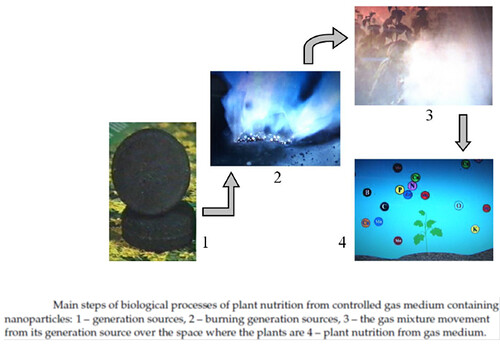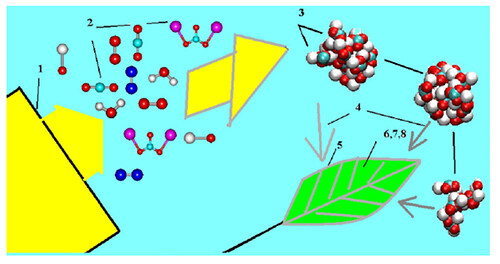The novel technologies used in greenhouses offer an effective method of producing vegetables and crops, which consist of micro elements and macro elements required for the utility of human being. The production of the crops as part of the technology can be intensified by providing mineral fertilizers that can provide extra nutrition to the roots and leaves of the plants. Though the mineral substances and drop irrigation are beneficial, heavy metal components and poisonous substances in the greenhouse soils will reach their threshold in two to three year period and the renewal has to be done by few thousands of tons of soil.
Gas phase greenhouse technology
To search for new ways of plant nutrition that reduces soil contamination is very important. In the light of this approach, greenhouse technology that involves plant nutrition using gas phase is reasonably favorable as the nutrition of the plant is attained by foliage and stem. The gas media were used since a long time for storing vegetables and fruits. The intensity of metabolism and respiratory activities are reduced by the major concentrations of oxygen, carbon-dioxide and nitrogen and water vapor.
Russian scientists have developed a nanobiotechnology, which represents nanoparticles used for the generation of eco-friendly vegetables and fruits in greenhouses. The major characteristic feature of this method is synthesis of gas medium comprising of nanoparticles belonging to macroelements and microelements that can enter into the leaves and stems of the crops. These elements will help in the metabolic activity of the plants. The gas medium is created by the products spreading at high temperatures.
The controlled gas medium (CGM) generation is done in the industrial greenhouse. The CGM is a complex medium that comprises of selected concentrations of inorganic compounds in the form of nanoparticles used for protecting the plants. These nanoparticles are utilized for controlling the diseases of living systems, foliar nutrition, protecting plants from frost, and seed treatment and so on.
This technology was used in greenhouses established in Ukraine, Russia, Byelorussia and China, which indicates that the controlled gas medium shows positive impact on the crop metabolism. Gas technology enhances the productivity, decreases the harmful substances, elevates the taste, and lengthens the duration of vegetation. The quantity of the mineral fertilizers used for this technology will be cut down to half. The investigations reveal that the nutrient concentrations in the leaves of the crops were increased by 2 to 3 times, when the crops were exposed to the gas medium for about two hours. Hence, the interaction processes involved between the nanosystems and plants as well as the synthesis of nanoparticles are very much important to be studied. This article discusses about the idea behind the theoretical basis of the experimental investigations and mathematical simulations of the above processes.

There are eight major phases in the plant nutrition process through gas medium.
• Movement of gas from the combustion source towards the plants.
• Formation of molecules consisting of the micro and macro elements.
• Cooling of the gas mixture to lower temperatures while merging the molecules and atoms into the nanoparticles.
• Movement of nanoparticles from the source in the gas medium.
• Accumulation of nanoparticles on the plant surface.
• Diffusion of nanoparticles into the plants from the surface.
• Nanoparticles movement inside the plant through the pores, intercellular spaces and cells.
• Disintegration of nanoparticles into atoms and molecules.
The below diagram represents the process of providing nutrition to the plant by the nanoparticles through gas medium.

The configuration of the molecular formations consisting of potassium, phosphorus and nitrogen and disintegration of nanoparticles into atoms and molecules are calculated using “ab initio” calculations. Molecular dynamics calculations are used for calculating the simulations associated with the process of formation of nanoparticles from molecules during the cooling of gas mixture.
The molecular simulations associated with the movement of nanoparticles in the gas medium, deposition of nanoparticles on the plant surface, permeation of nanoparticles into the plant and transport of these particles inside the plant from one place to another through the intercellular spaces, pores and so on are calculated using mesodynamics.
The theoretical understanding of the multilevel simulation related to the formation, movement, incorporation and disintegration of nanoparticles in the gas medium based on the thermodynamic conditions are operated on further to carry out this experiment. The molecular dynamics calculations take a lot of time and require computational power.
Due to the collective functioning of atoms, moelcules and nanoparticles occuring at different stages of simulation, this molecular dynamic application of nanoaerosols will create multilevel simulation problems. Hence, it is essential to use various mathematical approaches and models for the creation and presentation of nanoaerosols.
Calculations based on quantum mechanical procedures in the nanosystems depends on the atomic number present in the nanosystem, which does not exceed 2000. The nanoparticle movement in the gas medium and their accumulation is handled by mesodynamics, which include both molecular and classical dynamics.
The problems of aerosol nanotechnology can be solved with accuracy of the calculations. The reasons for transition from one simulation method to another are
• Reduction in the number of variables necessary for calculating movement of an atom and transition to the level of calculating the movement of collective nanoparticles.
• Reduction in the bonds existing between the elements of nanoparticles due to decrease in the number of interacting neighbors.
• Rise in the computational size of the nanosystem.
• Due to increase in time step of integration, the scale of nanosystem calculation in time is broadened.
Reference:
A.V.Vakhrushev, A.Yu.Fedotov, A.A.Vakhrishev, V.B.Golubchikov and E.V.Golubchikov (2012). The Plant nutrition from the Gas Medium in Greenhouses: Multilevel Simulation and Experimental Investigation, Plant Science, Dr.Nabin Kumar Dhal (Ed.), ISBN: 978-953-51-0905-1, InTech, DOI: 10.5772/53604. Available from http://www.intechopen.com/books/plant-science/the-plant-nutrition-from-the-gas-medium-in-greenhouses-multilevel-simulation-and-experimental-invest . Images embedded in the chapter 3 of the book 'Plant Science'
About Author / Additional Info: